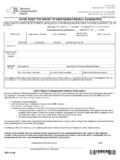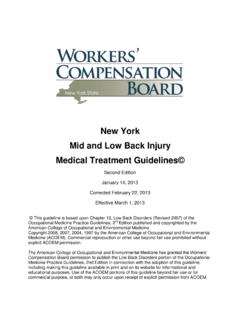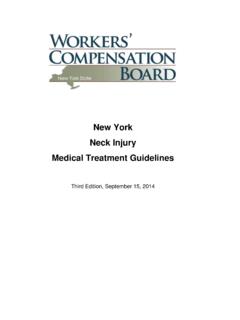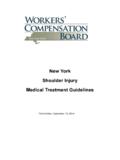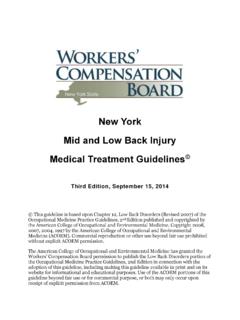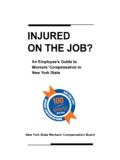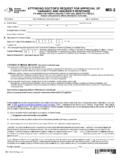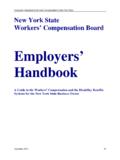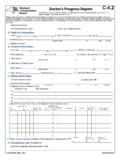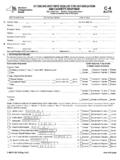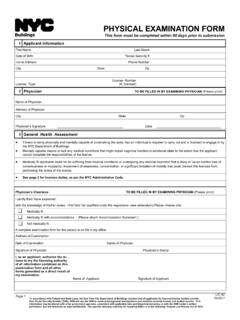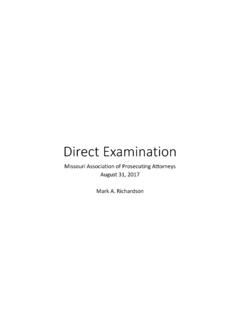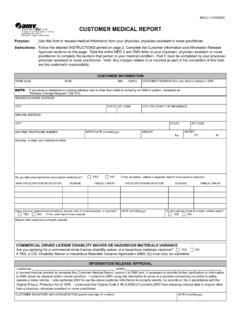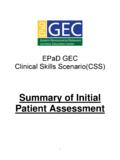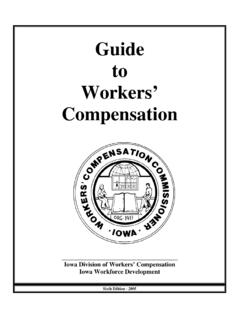Transcription of Workers' Compensation Guidelines for Determining Impairment
1 1 | Page Workers Compensation Guidelines for Determining Impairment First Edition, November 22, 2017 2 | Page Forward Legislation enacted in April 2017 [WCL 15(3)(x)] directed the Board to consult with representatives of labor, business, medical providers, insurance carriers, and self-insured employers regarding revisions to permanency Impairment Guidelines , including permitting review and comment by such representatives chosen medical , to adopt revised Guidelines for the evaluation of medical Impairment and determination of permanency with respect to injuries which are amenable to a schedule loss of use award pursuant to paragraphs (a) through (v) of subdivision 3 of section 15 of the WCL.
2 As the law directs, these Guidelines are to be ..reflective of advances in modern medicine that enhance healing and result in better outcomes. [WCL 15(3)(x)] Therefore, these revised permanency Guidelines supersede those sections of the Board s 2012 Impairment Guidelines concerning medical evaluation of injuries amenable to a schedule loss of use (chapters 1 through 8 of the 2012 Guidelines ), as well any other provision of the 2012 Impairment Guidelines which are inconsistent with these Guidelines . 3 | Page Table of Contents Chapter 1: Introduction .. 6 Types of Disability Under the Workers Compensation Law .. 6 Maximum medical Improvement (MMI) .. 6 Role of Examining medical Providers .. 6 Types of Final Evaluation Examinations.
3 7 Schedule Awards .. 8 Non-Schedule Awards (Classification) .. 8 Abbreviation Codes .. 9 Chapter 2: Upper Extremities Thumb and Fingers .. 10 Objectives for Determining Impairment for Thumb and 10 Methods Available to Assess Permanent Impairment .. 10 Maximum Rating of Body 10 Thumb .. 11 (A) Thumb Range of Motion .. 11 (B) Calculating Loss of Use of Thumb .. 13 (C) Thumb Special Considerations .. 15 Fingers .. 15 (A) Finger Range of Motion .. 15 (B) Calculating Loss of Use of Finger .. 16 (C) Finger Special Considerations .. 17 Loading .. 18 Amputation .. 20 Chapter 3: Upper Extremities Hand and Wrist .. 22 Objectives for Determining Impairment for Hand and Wrist .. 22 Methods Available to Assess Permanent Impairment .
4 22 Wrist Range of Motion .. 22 Calculating Loss of Use .. 24 Special Considerations .. 25 Amputation .. 25 Chapter 4: Upper Extremities - Elbow .. 26 Objectives for Determining Impairment for Elbow .. 26 Methods Available to Assess Permanent Impairment .. 26 Elbow Range of Motion .. 26 Calculating Loss of Use .. 27 Special Considerations .. 27 4 | Page Amputation .. 28 Chapter 5: Upper Extremities - Shoulder .. 29 Objectives for Determining Impairment for Shoulder .. 29 Methods Available to Assess Permanent Impairment .. 29 Shoulder Range of Motion .. 29 Calculating Loss of Use .. 30 Special Considerations .. 32 Amputation .. 33 Chapter 6: Hip and Femur .. 34 Objectives for Determining Impairment for Hip and Femur .. 34 Methods Available to Assess Permanent Impairment .
5 34 Hip Range of Motion .. 35 Calculating Loss of Use .. 36 Special Considerations .. 38 Amputation .. 40 Chapter 7: Knee and Tibia .. 41 Objectives for Determining Impairment for Knee and Tibia .. 41 Methods Available to Assess Permanent Impairment .. 41 Knee Range of Motion .. 41 Calculating Loss of Use .. 42 Special Considerations .. 43 Amputation .. 45 Chapter 8: Lower Extremities Ankle and Foot .. 46 Objectives for Determining Impairment for Ankle and Foot .. 46 Methods Available to Assess Permanent Impairment .. 46 Ankle Range of Motion .. 47 Calculating Loss of Use of the Foot .. 48 Special Considerations .. 49 Amputation .. 49 Chapter 9: Lower Extremity Great and Lesser Toes .. 50 Objectives for Determining Impairment for Toes.
6 50 Methods Available to Assess Permanent Impairment .. 50 Maximum Rating of Body 50 Great Toe .. 51 (A)Calculating Loss of Use of Great Toe .. 51 Smaller Toes (Second, Third, Fourth & Fifth) .. 52 5 | Page (A) Calculating Loss of Use of Smaller Toes .. 52 Amputations and Loading .. 53 Chapter 10: Central Nervous System Conditions, Peripheral Nerve Injuries and Entrapment / Compression Neuropathies .. 54 Central Nervous System - Cranial Nerves .. 54 Peripheral Nervous System .. 55 Entrapment / Compression Neuropathies .. 56 Chapter 11: Visual System/Auditory System/Facial Scars and Disfigurement .. 59 Visual System Introduction .. 59 Criteria and Methods for Evaluating Permanent Impairment .. 59 Loss of Hearing .. 62 Occupational Loss of Hearing.
7 62 Traumatic Loss of Hearing .. 62 Facial Scars and Disfigurement .. 63 APPENDIX A .. 64 6 | Page Chapter 1: Introduction Disability is a legal determination that reflects the impact of a workplace injury on a claimant s ability to work. The Workers Compensation Law Judge establishes the level of disability based on the available medical evidence and other relevant information. medical evidence may be submitted by the claimant s health provider, a medical consultant for the employer and/or an independent medical examiner. A distinction is made between disability and Impairment . Impairment is a purely medical determination made by a medical professional, and is defined as any anatomic or functional abnormality or loss.
8 Competent evaluation of Impairment requires a complete medical examination and accurate objective assessment of function. These Guidelines provide the medical provider with a uniform process for evaluating an individual's Impairment resulting from a medically documented work related injury or illness. Types of Disability Under the Workers Compensation Law This law establishes the following types of disability in workers Compensation cases: 1. Temporary total disability 2. Permanent total disability 3. Temporary partial disability 4. Permanent partial disability Evaluation of permanent disability occurs when there is a permanent Impairment remaining after the claimant has reached maximum medical improvement (MMI). These Guidelines were created for purposes of Determining Impairment for permanent disabilities.
9 Maximum medical Improvement (MMI) A finding of MMI is based on a medical judgment that (a) the claimant has recovered from the work injury or illness to the greatest extent that is expected and (b) no further improvement is reasonably expected. The need for palliative or symptomatic treatment does not preclude a finding of MMI. In cases that do not involve surgery or fractures, MMI cannot be determined prior to 6 months from the date of injury or disablement, unless otherwise stated or agreed to by the parties. Role of Examining medical Providers medical providers are obligated to provide the Board and the parties their best professional opinion of the claimant s medical condition, degree of Impairment , and functional abilities. These Guidelines provide detailed criteria for Determining the severity of a medical Impairment , with a greater weight given to objective findings.
10 It is the responsibility of the medical provider to submit medical evidence that the Board will consider in making a legal determination about disability. medical providers should not infer findings or manifestations that are not drawn from the physical examination or test reports, but rather medical providers should look to the objective 7 | Page findings of the physical examination and data contained within the medical records of the patient. This methodology is intended to foster consistency, predictability and inter-rater reliability for Determining Impairment . In order to prepare a report on permanent Impairment , the medical provider should do the following: 1. Identify the affected body part or system (include chapter, table number, class, and severity level for non-schedule disabilities) and review the Guidelines (for body parts not covered by the Guidelines , see Chapter on Other Injuries and Occupational Diseases [Default Guideline]).
